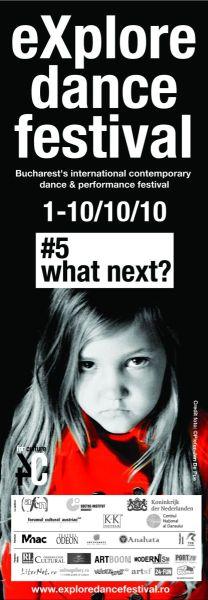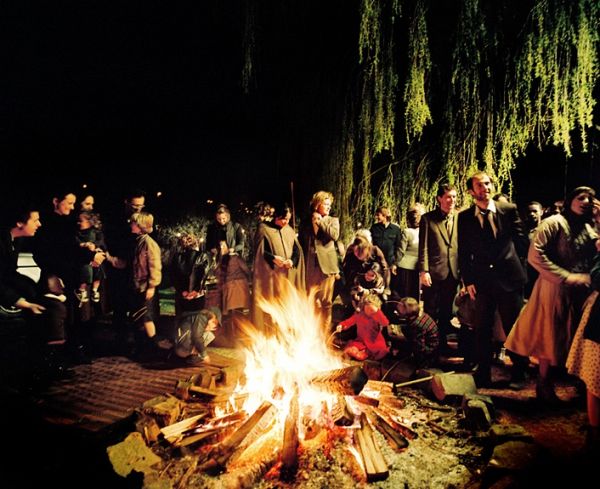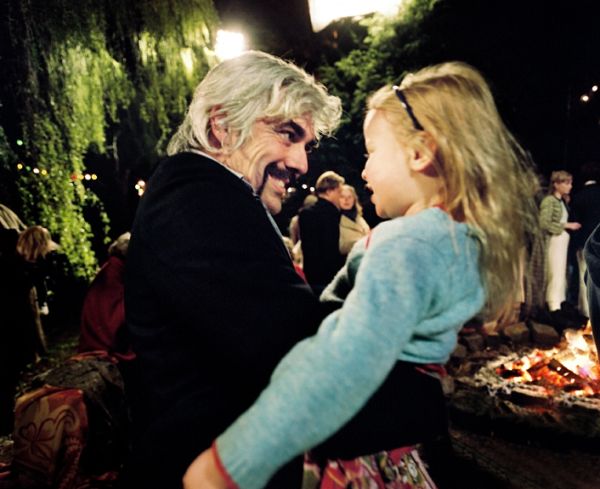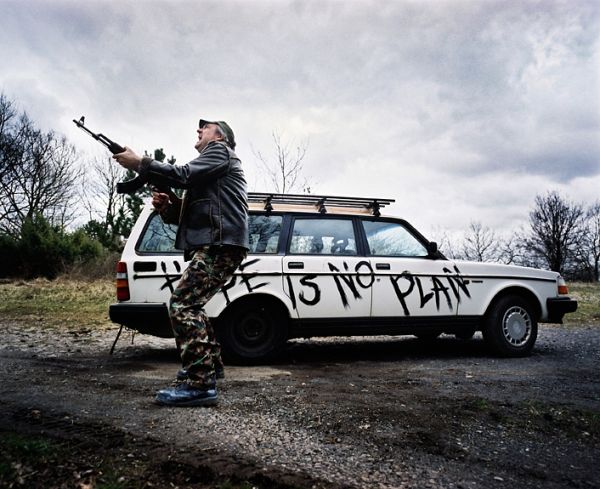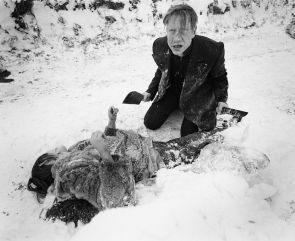Construcţia spectacolului, aparent labritinică, ne oferă un privilegiu. Putem, din orice unghi am aborda spectacolul, să găsim firul care să ne conducă, printre simbolurile riguros aşezate în acord, către înţelegerea mesajului. Să pornim de la titlul spectacolului: Monkey Sandwich (în limba flamandă Broodje Aap). O traducere literală din limba flamandă a termenului ne conduce către conceptul de legendă urbană. Cele două planuri ale spectacolului - planul scenei şi planul filmic- sunt construite pe o structură a cărei sursă este tocmai rezerva inepuizabilă de semnificaţii a legendelor urbane.
În planul scenic, un copil pe cale de a se naşte se află în relaţie cu lumea părinţilor săi, revelată prin intermediul unui film. Prin această structură a spectacolului, Wim Vandekeybus stabileşte o conexiune inedită între corporalitate şi imagine. Ceea ce este nenăscut primeşte substanţă concretă, materialitate efectivă, în timp ce lumea de afară este adăpostită într-un edificiu construit din imagini, din proiectţii care se configurează prin intermediul legendelor urbane din care este ţesut scenariul filmului.
Ceea ce ne spun legendele urbane este fără îndoială important şi trebuie acordată o atenţie specială subiectelor alese de Wim Vandekeybus: nu este deloc întâmplător că filmul proiectat ca parte integrantă din spectacol începe cu o situaţie dintr-un teatru. Un regizor (admirabil interpretat de actorul britanic Jerry Killick de la compania Forced Entertainment) le răstoarnă actorilor percepţiile tradiţionale despre convenţia teatrală, le bulversează concepţia despre ceea ce înseamnă a fi în scenă. Interogaţiile cu privire la natura actului teatral, la adevărul a ceea ce este înscenat, sunt extinse deliberat asupra produsului artistic pe care ni-l oferă Wim Vandekeybus.
Filmul continuă să se construiască pe osatura legendelor urbane. Fie că asistăm la ştergerea unor lumi printr-un potop simulat iniţial în lumea ludică a unei fetiţe sau privim o vânătoare de oameni, suntem martorii unei dinamici prin care sunt deconstruite percepţii tradiţionale ale graniţelor dintre uman şi non-uman, ale funcţiei limbajului, ale modului în care este înţeleasă corporalitatea.
În avalanşa de simboluri nimic nu este lăsat la voia întâmplării. Orice element acţionează ca o un bulgăre de zăpadă care acumulează sensuri duse până la explozia lor într-un plan care le modifică funcţia lor obişnuită. Modul în care este tratată dimensiunea temporală în spectacol reprezintă un exemplu relevant în acest sens: la capătul drumului, tatăl îşi poate intâlni fiul mai bătrân decât el, iar un copil nenăscut poate genera, prin absenţa unui destin prestabilit, configuraţia unei lumi proiectate sub forma unui puzzle de nenumărate posibilităţi.
Planul scenei şi planul filmului sunt conectate printr-o logică a relaţiei dintre corp şi imagine. În scenă , dintr-o indistincţie inţială se dezvoltă universul unui copil nenăscut. Maldărele de hârtie, ventilatoarele sau o cutie imensă de sticlă plină cu apă populează scena deasupra căreia se proiectează filmul. Prima mişcare pe care o face personajul din scenă (interpretat de Damien Chapelle) se produce în momentul în care în film problematica morţii atinge apogeul. Se stabileşte astfel o relaţie riguroasă între viaţă şi moarte, o dinamică a jocului dintre ceea ce pătrunde în nefiinţă şi ceea ce nu s-a născut încă.
Realitatea care prinde formă în scenă este conectată permanent la lumile care se intersectează, contrastează şi se armonizează în film. Spectacolul poate fi astfel supus unei duble modalităţi de citire a sensului său. Lumea filmului, ca rezervor mitologic, ne oferă sensul primordial al oricărui destin pe cale de a se forma. Legendele urbane povestite în film conţin principii şi sensuri care se pot regăsi în orice biografie şi care transcend graniţe culturale, bariere de limbaj sau paradigme sociale tradiţionale.
Pe de altă parte, faptul că în planul scenei asistăm la configurarea lumii unui copil nenăscut, adică a unei fiinţe care nu are încă un destin trasat, generează în planul filmului nenumărate posibilităţi prin care un destin ar putea fi generat. Naşterea copilului ar conduce la fixarea biografiei sale într-una din nenumăratele posibilităţi de dezvoltare.
Monkey Sandwich se impune astfel ca un spectacol în care este stabilită o punte între corp şi imagine, prin elaborarea unei surse inepuizabile de sensuri care rezidă în substanţa legendelor urbane. Modalităţi de limbaj aparent ireconciliabile se dovedesc purtătoare ale unor semnificaţii care îşi păstrează valabilitatea dincolo de orice spaţiu şi timp, şi mai ales dincolo de înţelegerea obişnuită a condiţiei umane.
Linkuri utile:
http://www.youtube.com/watch?v=QWMMbxJaPxw&feature=player_embedded
http://www.kvs.be/index2.php?page=program&discipline=&vs_id=508
http://www.ultimavez.com/
Fotografii de Pieter Jan De Pue
***
Monkey Sandwich - The Bridge Between Body and Image (Revisited)
We get back to the Explore Files with a more detailed analysis of the performance Monkey Sandwich by Wim Vandekeybus, presented in the opening of Explore Dance Festival 2010. In a general presentation of the event, I mentioned the fact that Monkey Sandwich is a perfect example of a synthesis of multiple artistic means, harmonized in such a way that they reveal a perfect meeting between the conceptual level, the visual plan of the performance and its narrative structure (and here I mention only the most visible aspects).
The labyrinth-like structure of the performance provides us with a privilege: no matter from what angle we choose to "read" the meanings, we can find the Ariadne clue meant to lead us to the understanding of the message, through the rigurously harmonized symbols.
Let's start with the title of the performance: Monkey Sandwich, Broodje Aap in Dutch. Literally translated, the term indicates the concept of urban legend. The two levels of the performance (the stage and the movie) are built on a structure which has a clear source: the unexhausting substance of the urban legends.
On stage, a child who is going to get born is permanently connected to the world of his parents, revelead through the movie. Wim Vandekeybus establishes so an original relation between body and image. What is still unborn is provided with a concrete materiality, while the outside world dwells in an edifice made of images, of projections that take shape out of the urban legends which the script of the movie is woven with.
No doubt, what the legends tell us is very important and a special attention must be paid to the topics chosen by Wim Vandekeybus: the fact that the movie starts with a theatre scene is extremely relevant. A stage director (wonderfully performed by Jerry Killick from the British Company Forced Entertainment) overthrowns the actors' traditional convictions related to theatrical conventions, to what being onstage means. The interrogations related to the very nature of theatre, to the truth of what is staged are deliberately expanded over the artistic product that Wim Vandekeybus offers us.
The movie continues to find its shape around the structure designed through the urban legends. Whether we witness a flood initially simulated in the playful world of a girl, or we watch a hunt of humans, we discover a dynamics through which traditional perceptions are deconstructed. The deconstruction aims at reconsidering the borders between human and non-human, the function of language or the way in which corporeality is understood.
Nothing happens at random in this avalanche of symbols. Every element acts as a snowball accumulating meanings finally brought to their explosion into another level of understanding. The view on the temporal dimension is a relevant example in this respect: at the end of the way, a father can meet his son which is older than him, or an unborn child can generate, through the absence of an established fate, a world like a puzzle of endless possibilities.
The reality of the stage and the world of the movie are connected through the logics of the relation between body and image. The mountains of paper, the ventilators, or the huge glass box filled with water initially inhabit the stage above which the movie is being projected. The first move made by the character on stage (performed by Damien Chapelle) is made the very moment when the problematics of death reaches its climax in the movie. Therefore, a rigurous relation is established between life and death, between what is entering non-being and what is still unborn.
The reality that we see evolving on stage is incessantly connected to the worlds that cross, oppose and harmonize one another in the movie. The performance can thus be submitted to a double reading.
On one hand, the world of the movie, as a fountain of myths, offers the primordial sense of any destiny that is going to be born. The legends narrated in the movie contain principles and meanings that can be detected in every biography and surpass cultural barriers or traditional social patterns.
On the other hand, by the fact that we witness the world of an unborn child who does not have yet an established destiny, multiple possibilites are generated at the level of the film reality. The birth of the child would lead to the enclosure of his biography within the limits of only one possibility of development.
Therefore, Monkey Sandwich can be understood as a perfomance that finds a bridge between body and image, by elaborating a source of significances that reside in the substance of urban legends. Structures of language which are seemingly impossible to reconcile prove to be generators of meanings which remain valid beyond any time and space and especially beyond the common understanding of human condition.
Useful links:
http://www.youtube.com/watch?v=QWMMbxJaPxw&feature=player_embedded
http://www.kvs.be/index2.php?page=program&discipline=&vs_id=508
http://www.ultimavez.com/
Photos by Pieter Jan De Pue
